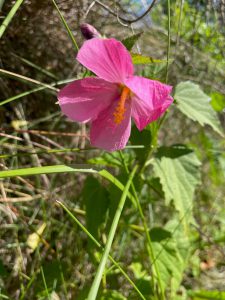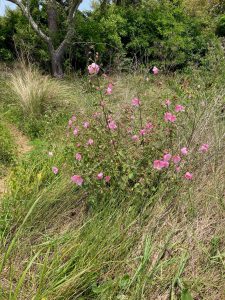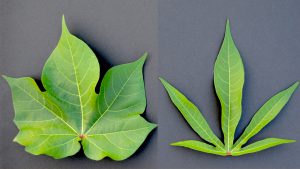
A colorful flower in bloom is often the first thing people notice when they head outside. At any given time of year, I try to make a point of knowing what’s blooming in the woods, because if I’m with a group of people they’ll always ask me what it is. Lately in the freshwater wetlands around us, a few eye-catching pink flowers with large leaves are showing off. If you were to see one and be reminded of a hibiscus, you’d be correct in that assumption. There are six species of hibiscus native to freshwater wetlands in the state, with all but one typically found in north Florida.

The most stunning varieties, in my opinion, are the pink Virginia saltmarsh mallow (Kosteletzkya pentacarpos) and pinkish red swamp hibiscus (Hibiscus coccineus). These plants can grow 6 to 9 feet tall, towering over the marshes around it. Within the broad pink petals, a pronounced yellow stamen protrudes from the center of the male flower. Their pollen attracts bees, moths, butterflies, and hummingbird species.

Another common name for some of these varieties is the marsh mallow. While it may sound odd to hear a plant that sounds like something from a list of s’mores ingredients, there’s a good reason. Hibiscus are part of the Malvaceae (Latin for “mauve”) family, which includes okra and cotton (look at the similarity in leaf shape). Hibiscus leaves are sometimes mistaken for another familiar and popular plant, but that’s a topic for another blog.

Malvaceae also includes a species indigenous to Africa, Asia, and Europe called Althaea officianalis, also known commonly as the marsh mallow. Its genus name, Althaea, comes from the Greek “to heal or cure.” The high sap content in the Old World marsh mallow plant was used for medicinal purposes, particularly in cold symptoms like coughs and sore throats. It could be dried for tea, cooked, or ingested raw. The ancient Egyptians made a sweet treat from the plant’s roots, which over time (and help from French bakers) evolved into the marshmallow we know and love. It is probably not a surprise that there is no actual “marsh mallow” in the modern marshmallow anymore–but next time you’re roasting one over a fire, you can thank the hibiscus plant for its existence!
 10
10
